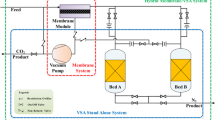Abstract
A novel pervaporation technique has been proposed that makes it possible to selectively remove volatile chlorinated organics (VCO) from contaminated water; to localize them on activated carbon directly in the membrane module; to create a sufficient driving force of the process due to both high sorption capacity of activated carbon and its VCO adsorption selectivity; and to abandon the use of expensive vacuum equipment, thereby minimizing vacuum pump operating costs. The influence of VCO concentration in the solution and the feed flow rate on the efficiency of VCO removal from water has been studied. It has been found that the dominant resistance to VCO flux through the membrane is due to an additional flux resistance associated with diffusion constraints in the boundary liquid layer near the membrane surface. It has been shown that VCO flux values in the case of this pervaporation method (up to 0.47 kg/(m2 h) at 30°C) are several times larger than those for conventional pervaporation approaches. The separation factor can be as high as 380–2400 for a chloroform/water mixture or 400–4800 for a trichloroethylene/water mixture.
Similar content being viewed by others
References
R. Loos, G. Locoro, S. Comero, et al., Water Res. 44, 4115 (2010).
O. Hutzinger, B. Beek, and M. Metzler, The Handbook of Environmental Chemistry (Springer, Berlin, 2013).
J. P. Scott and D. F. Ollis, Environ. Prog. Sust. Energ. 14, 88 (1995).
M. S. El-Shahawi, A. Hamza, A. S. Bashammakh, and W. T. Al-Saggaf, Talanta 80, 1587 (2010).
J. Hara, Organic Pollutants Ten Years After the Stockholm Convention—Environmental and Analytical Update, Ed. by T. Puzyn and A. Mostrag-Szlichtyng (InTech, Rijeka, 2012), p. 345.
P. Bhatt, M. S. Kumar, S. Mudliar, and T. Chakrabarti, Crit. Rev. Env. Sci. Technol. 37, 165 (2007).
S. Yu. Larionov, A. A. Panteleev, B. E. Ryabchikov, et al., Vodosnab. Sanit. Tekh. 4, 12 (2015).
M. N. Rashed, Organic Pollutants—Monitoring, Risk and Treatment, Ed. by M. N. Rashed (InTech, Rijeka, 2013), p. 167.
B. Pavoni, D. Drusian, A. Giacometti, and M. Zanette, Water Res. 40, 3671 (2006).
M. Peng, L. M. Vane, and S. X. Liu, J. Hazard. Mater. 98, 69 (2003).
K. Everaert and J. Baeyens, J. Hazard. Mater. 109, 113 (2004).
Chemistry Beyond Chlorine, Ed. by P. Tundo, L.-N. He, E. Lokteva, and C. Mota (Springer International, Switzerland, 2016).
H. S. Hu, Fluid Phase Equilib. 289, 80 (2010).
I. L. Borisov and V. V. Volkov, Sep. Purif. Technol. 146, 33 (2015).
A. Kujawska, J. Kujawski, M. Bryjak, and W. Kujawski, Chem. Eng. Process. 94, 62 (2015).
I. L. Borisov, G. S. Golubev, V. P. Vasilevsky, et al., J. Membr. Sci. 523, 291 (2017).
MDK Composite Gas Separation Membranes (ZAO NTTs Vladipor). https://doi.org/www.vladipor.ru/catalog/&cid=008, 2017.
M. Hoshi, M. Ieshige, T. Saitoh, and T. Nakagawa, J. Appl. Polym. Sci. 76, 654 (2000).
H. H. Nijhuis, M. H. V. Mulder, and C. A. Smolders, J. Membr. Sci. 61, 99 (1991).
A. Das, I. Abou-Nemeh, S. Chandra, and K. K. Sirkar, J. Membr. Sci. 148, 257 (1998).
S. Schnabel, P. Moulin, Q. T. Nguyen, et al. J. Membr. Sci. 142, 129 (1998).
T. Q. Nguyen and K. Nobe, J. Membr. Sci. 30, 11 (1987).
I. Blume, J. G. Wijmans, and R. W. Baker, J. Membr. Sci. 49, 253 (1990).
J. G. Wijmans, A. L. Athayde, R. Daniels, J. H. Ly, et al., J. Membr. Sci. 109, 135 (1996).
D. Venkatesulu, P. Venkatesu, and M. P. Rao, J. Chem. Eng. Data 42, 365 (1997).
R. W. Baker, J. G. Wijmans, A. L. Athayde, et al., J. Membr. Sci. 137, 159 (1997).
W. Hayduk and H. Laudie, AIChE J. 20, 611 (1974).
H. O. Karlsson and G. Trägårdh, J. Membr. Sci. 81, 163 (1993).
M. She and S. T. Hwang, J. Membr. Sci. 236, 193 (2004).
Author information
Authors and Affiliations
Corresponding author
Additional information
Original Russian Text © I.L. Borisov, 2018, published in Membrany i Membrannye Tekhnologii, 2018, Vol. 8, No. 3, pp. 166–174.
Rights and permissions
About this article
Cite this article
Borisov, I.L. Novel Pervaporation Technique Using Permeate Vapor Adsorption for Removal of Chlorinated Organics from Aqueous Media. Pet. Chem. 58, 482–489 (2018). https://doi.org/10.1134/S0965544118060038
Received:
Published:
Issue Date:
DOI: https://doi.org/10.1134/S0965544118060038




